FLIGHT & BARR ROYAL WORCESTER ORIGINAL WRYTHEN TRIO SET c. 1795 THISTLE PATTERN
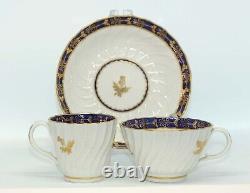
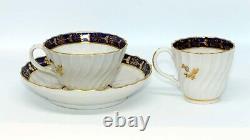
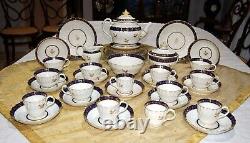
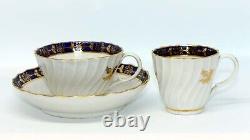
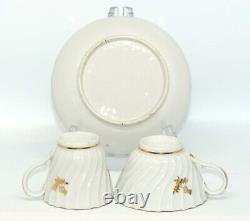
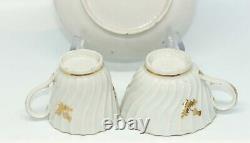
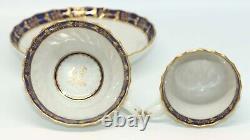

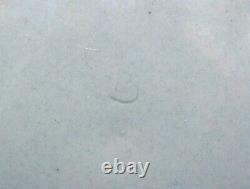
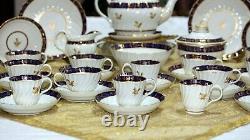
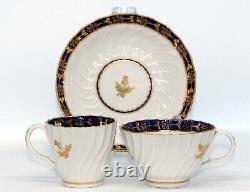
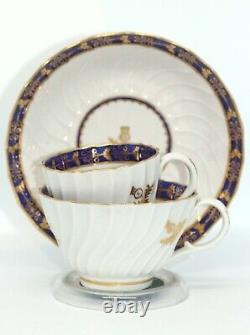

Flight Barr Worcester true'trio. This is what was originally. Known as a trio - these.
Days this term refers to. Part of a much more extensive. This listing is for one trio. All three pieces have Wrythen.
Twisted ribbed design to body. All pieces are decorated with the. Same glorious cobalt blue bands.
With hand applied pure gold leaf. Design and the lovely gold thistles. That just gleam in the light. Which dates them to between.Very faint'B' underneath each piece. Which I have shown in one photo with.
Autocorrecting as they are very. This tea and coffee set mainly dates to. The late 1700s or very early 1800s except.
For six identical saucers (listed separately). That have been added about 100 years later. Possibly to extend the setting so you could. Serve tea and coffee together and they would. I can find no evidence that Royal Worcester.
Continued making this pattern into the early. Century so it is possible the owners.Commissioned Royal Worcester to make. The six later saucers expressly for them. Regrettably we have to split it all up. To sell as trying to pack so many fragile.
Pieces of porcelain to withstand being. Sent through the post together would. Not only be a nightmare but the cost to.
The purchaser would be exorbitant. If anyone in Australia is interested. In a large number of pieces or the. Whole set we would be happy to. Price and help get a good Carrier to.Deliver them when next going to your. Area which should be cheaper and. All three pieces are in very.
No chips, cracks, crazing or. All ping well when tapped.
A few faint surface usage marks. A little wear to gold gilding on. Top rims mainly but really all. Three are in extremely good.
A light sprinkling of kiln grit inside. The teacup - see photo - but.Close-up photo makes it look. A lot worse than in real life. Kiln grit is quite a common occurrence. In this English soft-paste porcelain.
And pottery production in general. Most of the cups and some of. The other pieces in this set have it. Any little brown specks of colour. And/or unevenness to the foot rim. Of any piece is all original.14.5cm (5 3/4) wide &. 3.2cm (1 1/4) high. 9.2cm (3 9/16) across body. 5.7cm (2 1/4) high.
Coffee demitasse cup is approx. 7cm (2 11/16) across body. 6.3cm (2 1/2) high. Tea first arrived in Britain in the 1650s.And gained popularity throughout the. The Chinese had been drinking tea. For around 1600 years by this stage.
And typically drank it from small cups. Or tea bowls (without handles) as.
Small bowls helped to keep the. The British however showed a preference. For a teacup with a handle and English. Pottery factories began to emerge. Only ceramic wares generally but. These handled tea bowls or teacups. Favoured by the British tea drinkers. However the Chinese tea wares being.Imported at this time were made from. True' porcelain or hard-paste porcelain. Which included'china clay' or kaolin. The key element to making this strong. High (temperature) fired porcelain that.
Could withstand boiling water being. As the formulae to make'hard-paste. Porcelain was known only to Asian potters.
At this time their European counterparts. Struggled to make a product without the.
Inclusion of the key element, kaolin. That was required for the items to.
Withstand the high firing temperatures. In a kiln that produced this far superior.
As it turns out kaolin is not widely available. In Europe anyway so its inclusion was. Going to be difficult anyway even if.They did know about it and so the. Porcelain - a substance that didn't require. High firing temperatures and couldn't withstand. High firing temperatures which made it.
Slump in the kiln which is why it was called. It looked like Chinese porcelain but. Lacked all the key elements to make.
It strong enough to not crack or. Shatter when subjected to boiling water. The very earliest attempts in the 16. In Italy was initially produced with just clay and. Ground up glass or frit. As others struggled to re-produce. Next 200 years soapstone and lime. Were also added along with quartz and. A number of other elements but of. Course not kaolin which they didn't. Have much access to anyway. Finally the German Meissen factory. 1708, and later German factories usually.Managed to find the secret out from former. Other European countries had much longer to.
Wait, but most factories eventually switched. From soft to hard-paste, having discovered. Both the secret and a source of kaolin.
In England there was a movement in a. Different direction, as Spode's formula for.
Bone china', developed in the 1790s, and. Was adopted by most other factories. By about 1820 and so at this stage little. Soft-paste porcelain was being made anywhere. In England and little hard-paste either. Bone china was the new porcelain. However in 1751, the physician, Dr John Wall. Along with an apothecary named William. Davis and 13 other businessmen, established. The manufactory at Warmstry House. On the banks of the River Severn.They initially called it the Worcester Tonquin. Manufactory with the idea of developing their. Own'porcelain' to compete head on with. In 1752, Worcester acquired the Lund's. Bristol Works who were making soft-paste.
Porcelain with the inclusion of soapstone. Which produced a product that could. When the Worcester works took over.Lund's factory in 1752, not only did all the. Undecorated items pass to them but also. The licence to mine 20 tons of soaprock. In fact, this licence was bought by a major. Shareholder, a Mr Holdship, which ensured.
The business could continue to make. Lund and his staff were taken on by. Worcester Porcelain - perhaps to. Prevent industrial leaks about the. To earlier in the century to Meissen. Cobalt blue pigment was one of the few colours. That could withstand the high firing temperatures. Required, and this partly accounts for its. The early decorative influences were largely. Chinese and captured the spirit of Chinoiserie.Through Chinese scenes, figures, flora, and fauna. Japanese porcelain began to arrive in Britain. In the late 17th century and ceramic designs. Known as "Kakiemon" also influenced the. Another challenge for the porcelain industry.
Was to produce quality decoration in a. Timely manner that could compete with.
The less expensive Chinese Imports. Several people were working on this. But it was in Worcester that printed. Decoration was first used on a. In about 1757, Robert Hancock was perfecting. A method of transfer printing onto porcelain. Hancock was a well-known engraver and. Etcher, and Richard and Josiah Holdship. Who were the managers of the Worcester factory. Were very interested in his ideas. He used engraved copper plates for the early.Quite soon, their products included underglaze. Prints in blue and overglaze prints, mostly in black.
This first period of Worcester is also referred. To as the "Dr Wall" period, after the co-founder. Which extends from the company's foundation. Until the sale of the business in1783 to. Thomas Flight, their London Agent. Dr Wall retired in 1774 and his partners.Continued on without him until Thomas. Flight let his two sons run the concern. With John Flight taking the lead role. Till his father's death in 1792. Knowledge of this period is largely a.
Result of the excellent diary that John. During this period, the factory was in. Poor repair and production was limited. To low-end patterns of mostly blue and. White porcelains still copying the popular. Chinese porcelain but they were under. Pressure by the competition from these.And also from a new player. Thomas Turner's Caughley Factory. Martin Barr joined the Worcester factory. As a partner in 1792. Porcelains of this period are often.
Identified by an incised capital "B". And later, by more elaborate printed. Thomas Flight died in 1800, leaving the factory. In the hands of his son Joseph Flight and. Barr's sons, Martin Barr Jr and George Barr were.Being prepared at that time to run the factory. The factory had received a royal warrant from. King George III in 1789 during his visit to the city. Which is when they became Royal Worcester. Others followed, including a Royal Warrant by.
The Prince of Wales in 1807, another granted. By the Princess of Wales in 1808. The factory is still in service to the crown.By appointment to Her Majesty. We guarantee our descriptions are accurate.
Please bear in mind that all our items are antique or. Vintage and may have some age related issues. If you like your item please leave us feedback.
And we will respond immediately. If, for any reason, you are unhappy. Come back to us so we can try and. Resolve any issue you might have. If you are undercharged we don't ask for more.Any questions or query's please contact so we can look into it. These charges are the buyers responsibility. Determine what these additional costs will be prior. For a very long time now and hopefully will.
Be for a long time to come. Between 2007 and 2018 we were also. Which has now sadly closed as our old building was. This item is in the category "Pottery & Glass\Decorative Cookware, Dinnerware & Serveware\Cup & Saucers".
The seller is "kollectik1" and is located in this country: AU. This item can be shipped worldwide.
- Shape: Wrythen or shanked
- Handmade: Yes
- Production Technique: hand gilded
- Colour: White, cobalt blue and real gold
- Country/Region of Manufacture: United Kingdom
- Style: Georgian
- Backstamp: Incised
- Material: English soft-paste porcelain, Porcelain
- Theme: Scottish thistles
- Pattern: Thistle
- Type: Teacup, coffee cup and saucer TRIO
- Features: Collectable
- Year Manufactured: 1795
- Finish: Glossy
- Number of Items in Set: Three-Piece
- Origin: England
- Occasion: Afternoon tea or coffee
- Brand: Royal Worcester
- Set Includes: Teacup, coffee cup and saucer TRIO
- Production Style: Wrythen or shanked
- Original/Licensed Reproduction: Original
- Manufacturer Warranty: I think not
- Time Period Manufactured: 1750-1799

